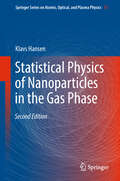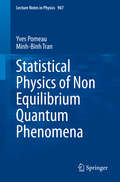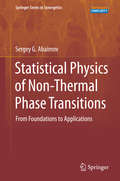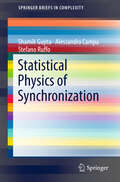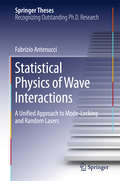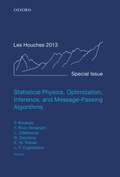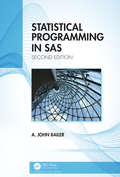- Table View
- List View
Statistical Physics of Nanoparticles in the Gas Phase (Springer Series on Atomic, Optical, and Plasma Physics #73)
by Klavs HansenThermal processes are ubiquitous and an understanding of thermal phenomena is essential for a complete description of the physics of nanoparticles, both for the purpose of modeling the dynamics of the particles and for the correct interpretation of experimental data.The second edition of this book follows the logic of first edition, with an emphasis on presentation of literature results and to guide the reader through derivations. Several topics have been added to the repertoire, notably magnetism, a fuller exposition of aggregation and the related area of nucleation theory. Also a new chapter has been added on the transient hot electron phenomenon. The book remains focused on the fundamental properties of nanosystems in the gas phase. Each chapter is enriched with additional new exercises and three Appendices provide additional useful material.
Statistical Physics of Non Equilibrium Quantum Phenomena (Lecture Notes in Physics #967)
by Yves Pomeau Minh-Binh TranThis book provides an introduction to topics in non-equilibrium quantum statistical physics for both mathematicians and theoretical physicists. The first part introduces a kinetic equation, of Kolmogorov type, which is needed to describe an isolated atom (actually, in experiments, an ion) under the effect of a classical pumping electromagnetic field which keeps the atom in its excited state(s) together with the random emission of fluorescence photons which put it back into its ground state. The quantum kinetic theory developed in the second part is an extension of Boltzmann's classical (non-quantum) kinetic theory of a dilute gas of quantum bosons. This is the source of many interesting fundamental questions, particularly because, if the temperature is low enough, such a gas is known to have at equilibrium a transition, the Bose–Einstein transition, where a finite portion of the particles stay in the quantum ground state. An important question considered is how a Bose gas condensate develops in time if its energy is initially low enough.
Statistical Physics of Non-Thermal Phase Transitions: From Foundations to Applications (Springer Series in Synergetics)
by Sergey G. AbaimovThis book addresses the application of methods used in statistical physics to complex systems—from simple phenomenological analogies to more complex aspects, such as correlations, fluctuation-dissipation theorem, the concept of free energy, renormalization group approach and scaling. Statistical physics contains a well-developed formalism that describes phase transitions. It is useful to apply this formalism for damage phenomena as well. Fractals, the Ising model, percolation, damage mechanics, fluctuations, free energy formalism, renormalization group, and scaling, are some of the topics covered in Statistical Physics of Phase Transitions.
Statistical Physics of Synchronization (SpringerBriefs in Complexity)
by Shamik Gupta Alessandro Campa Stefano RuffoThis book introduces and discusses the analysis of interacting many-body complex systems exhibiting spontaneous synchronization from the perspective of nonequilibrium statistical physics. While such systems have been mostly studied using dynamical system theory, the book underlines the usefulness of the statistical physics approach to obtain insightful results in a number of representative dynamical settings. Although it is intractable to follow the dynamics of a particular initial condition, statistical physics allows to derive exact analytical results in the limit of an infinite number of interacting units. Chapter one discusses dynamical characterization of individual units of synchronizing systems as well as of their interaction and summarizes the relevant tools of statistical physics. The latter are then used in chapters two and three to discuss respectively synchronizing systems with either a first- or a second-order evolution in time. This book provides a timely introduction to the subject and is meant for the uninitiated as well as for experienced researchers working in areas of nonlinear dynamics and chaos, statistical physics, and complex systems.
Statistical Physics of Wave Interactions: A Unified Approach to Mode-Locking and Random Lasers (Springer Theses)
by Fabrizio AntenucciThis thesis reveals the utility of pursuing a statistical physics approach in the description of wave interactions in multimode optical systems. To that end, the appropriate Hamiltonian models are derived and their limits of applicability are discussed. The versatility of the framework allows the characterization of ordered and disordered lasers in open and closed cavities in a unified scheme, from standard mode-locking to random lasers. With the use of replica method and Monte Carlo simulations, the models are categorized on the basis of universal properties, and nontrivial predictions of experimental relevance are obtained. In particular, the approach makes it possible to nonperturbatively treat the interplay between disorder and nonlinearity and to envisage novel and fascinating physical phenomena such as glassy random lasers, providing a novel way to experimentally investigate replica symmetry breaking.
Statistical Physics, Optimization, Inference, and Message-Passing Algorithms: Lecture Notes of the Les Houches School of Physics: Special Issue, October 2013 (Lecture Notes of the Les Houches Summer School)
In the last decade, there have been an increasing convergence of interest and methods between theoretical physics and fields as diverse as probability, machine learning, optimization and compressed sensing. In particular, many theoretical and applied works in statistical physics and computer science have relied on the use of message passing algorithms and their connection to statistical physics of spin glasses. The aim of this book, especially adapted to PhD students, post-docs, and young researchers, is to present the background necessary for entering this fast developing field.
Statistical Portfolio Estimation
by Masanobu Taniguchi Hiroshi Shiraishi Junichi Hirukawa Hiroko Kato Solvang Takashi YamashitaThe composition of portfolios is one of the most fundamental and important methods in financial engineering, used to control the risk of investments. This book provides a comprehensive overview of statistical inference for portfolios and their various applications. A variety of asset processes are introduced, including non-Gaussian stationary processes, nonlinear processes, non-stationary processes, and the book provides a framework for statistical inference using local asymptotic normality (LAN). The approach is generalized for portfolio estimation, so that many important problems can be covered. This book can primarily be used as a reference by researchers from statistics, mathematics, finance, econometrics, and genomics. It can also be used as a textbook by senior undergraduate and graduate students in these fields.
Statistical Portfolio Estimation
by Masanobu Taniguchi Hiroshi Shiraishi Junichi Hirukawa Hiroko Kato Solvang Takashi YamashitaThe composition of portfolios is one of the most fundamental and important methods in financial engineering, used to control the risk of investments. This book provides a comprehensive overview of statistical inference for portfolios and their various applications. A variety of asset processes are introduced, including non-Gaussian stationary processes, nonlinear processes, non-stationary processes, and the book provides a framework for statistical inference using local asymptotic normality (LAN). The approach is generalized for portfolio estimation, so that many important problems can be covered. This book can primarily be used as a reference by researchers from statistics, mathematics, finance, econometrics, and genomics. It can also be used as a textbook by senior undergraduate and graduate students in these fields.
Statistical Power Analysis: A Simple and General Model for Traditional and Modern Hypothesis Tests, Fourth Edition
by Kevin R. Murphy Brett Myors Allen WolachNoted for its accessible approach, this text applies the latest approaches of power analysis to both null hypothesis and minimum-effect testing using the same basic unified model. Through the use of a few simple procedures and examples, the authors show readers with little expertise in statistical analysis how to obtain the values needed to carry out the power analysis for their research. Illustrations of how these analyses work and how they can be used to choose the appropriate criterion for defining statistically significant outcomes are sprinkled throughout. The book presents a simple and general model for statistical power analysis based on the F statistic and reviews how to determine: the sample size needed to achieve desired levels of power; the level of power needed in a study; the size of effect that can be reliably detected by a study; and sensible criteria for statistical significance. The book helps readers design studies, diagnose existing studies, and understand why hypothesis tests come out out the way they do. The fourth edition features: -New Boxed Material sections provide examples of power analysis in action and discuss unique issues that arise as a result of applying power analyses in different designs. -Many more worked examples help readers apply the concepts presented. -Expanded coverage of power analysis for multifactor analysis of variance (ANOVA) to show readers how to analyze up to four factors with repeated measures on any or all of the factors. -Re-designed and expanded web based One Stop F Calculator software and data sets that allow users to perform all of the book's analyses and conduct significance tests, power analyses, and assessments of N and alpha needed for traditional and minimum-effects tests. -Easy to apply formulas for approximating the number of subjects required to reach adequate levels of power in a wide range of studies. Intended as a supplement for graduate/advanced undergraduate courses in research methods or experimental design, intermediate, advanced, or multivariate statistics, statistics II, or psychometrics, taught in psychology, education, business, and other social and health sciences, researchers also appreciate the book‘s applied approach.
Statistical Power Analysis: A Simple and General Model for Traditional and Modern Hypothesis Tests, Fourth Edition
by Kevin R. Murphy Brett Myors Allen WolachNoted for its accessible approach, this text applies the latest approaches of power analysis to both null hypothesis and minimum-effect testing using the same basic unified model. Through the use of a few simple procedures and examples, the authors show readers with little expertise in statistical analysis how to obtain the values needed to carry out the power analysis for their research. Illustrations of how these analyses work and how they can be used to choose the appropriate criterion for defining statistically significant outcomes are sprinkled throughout. The book presents a simple and general model for statistical power analysis based on the F statistic and reviews how to determine: the sample size needed to achieve desired levels of power; the level of power needed in a study; the size of effect that can be reliably detected by a study; and sensible criteria for statistical significance. The book helps readers design studies, diagnose existing studies, and understand why hypothesis tests come out out the way they do. The fourth edition features: -New Boxed Material sections provide examples of power analysis in action and discuss unique issues that arise as a result of applying power analyses in different designs. -Many more worked examples help readers apply the concepts presented. -Expanded coverage of power analysis for multifactor analysis of variance (ANOVA) to show readers how to analyze up to four factors with repeated measures on any or all of the factors. -Re-designed and expanded web based One Stop F Calculator software and data sets that allow users to perform all of the book's analyses and conduct significance tests, power analyses, and assessments of N and alpha needed for traditional and minimum-effects tests. -Easy to apply formulas for approximating the number of subjects required to reach adequate levels of power in a wide range of studies. Intended as a supplement for graduate/advanced undergraduate courses in research methods or experimental design, intermediate, advanced, or multivariate statistics, statistics II, or psychometrics, taught in psychology, education, business, and other social and health sciences, researchers also appreciate the book‘s applied approach.
Statistical Power Analysis: A Simple and General Model for Traditional and Modern Hypothesis Tests, Fifth Edition
by Brett Myors Kevin R. MurphyStatistical Power Analysis explains the key concepts in statistical power analysis and illustrates their application in both tests of traditional null hypotheses (that treatments or interventions have no effect in the population) and in tests of the minimum-effect hypotheses (that the population effects of treatments or interventions are so small that they can be safely treated as unimportant). It provides readers with the tools to understand and perform power analyses for virtually all the statistical methods used in the social and behavioral sciences. Brett Myors and Kevin Murphy apply the latest approaches of power analysis to both null hypothesis and minimum-effect testing using the same basic unified model. This book starts with a review of the key concepts that underly statistical power. It goes on to show how to perform and interpret power analyses, and the ways to use them to diagnose and plan research. We discuss the uses of power analysis in correlation and regression, in the analysis of experimental data, and in multilevel studies. This edition includes new material and new power software. The programs used for power analysis in this book have been re-written in R, a language that is widely used and freely available. The authors include R codes for all programs, and we have also provided a web-based app that allows users who are not comfortable with R to perform a wide range of analyses using any computer or device that provides access to the web. Statistical Power Analysis helps readers design studies, diagnose existing studies, and understand why hypothesis tests come out the way they do. The fifth edition includes updates to all chapters to accommodate the most current scholarship, as well as recalculations of all examples. This book is intended for graduate students and faculty in the behavioral and social sciences; researchers in other fields will find the concepts and methods laid out here valuable and applicable to studies in many domains.
Statistical Power Analysis: A Simple and General Model for Traditional and Modern Hypothesis Tests, Fifth Edition
by Brett Myors Kevin R. MurphyStatistical Power Analysis explains the key concepts in statistical power analysis and illustrates their application in both tests of traditional null hypotheses (that treatments or interventions have no effect in the population) and in tests of the minimum-effect hypotheses (that the population effects of treatments or interventions are so small that they can be safely treated as unimportant). It provides readers with the tools to understand and perform power analyses for virtually all the statistical methods used in the social and behavioral sciences. Brett Myors and Kevin Murphy apply the latest approaches of power analysis to both null hypothesis and minimum-effect testing using the same basic unified model. This book starts with a review of the key concepts that underly statistical power. It goes on to show how to perform and interpret power analyses, and the ways to use them to diagnose and plan research. We discuss the uses of power analysis in correlation and regression, in the analysis of experimental data, and in multilevel studies. This edition includes new material and new power software. The programs used for power analysis in this book have been re-written in R, a language that is widely used and freely available. The authors include R codes for all programs, and we have also provided a web-based app that allows users who are not comfortable with R to perform a wide range of analyses using any computer or device that provides access to the web. Statistical Power Analysis helps readers design studies, diagnose existing studies, and understand why hypothesis tests come out the way they do. The fifth edition includes updates to all chapters to accommodate the most current scholarship, as well as recalculations of all examples. This book is intended for graduate students and faculty in the behavioral and social sciences; researchers in other fields will find the concepts and methods laid out here valuable and applicable to studies in many domains.
Statistical Power Analysis for the Social and Behavioral Sciences: Basic and Advanced Techniques
by Xiaofeng Steven LiuThis is the first book to demonstrate the application of power analysis to the newer more advanced statistical techniques that are increasingly used in the social and behavioral sciences. Both basic and advanced designs are covered. Readers are shown how to apply power analysis to techniques such as hierarchical linear modeling, meta-analysis, and structural equation modeling. Each chapter opens with a review of the statistical procedure and then proceeds to derive the power functions. This is followed by examples that demonstrate how to produce power tables and charts. The book clearly shows how to calculate power by providing open code for every design and procedure in R, SAS, and SPSS. Readers can verify the power computation using the computer programs on the book's website. There is a growing requirement to include power analysis to justify sample sizes in grant proposals. Most chapters are self-standing and can be read in any order without much disruption.This book will help readers do just that. Sample computer code in R, SPSS, and SAS at www.routledge.com/9781848729810 are written to tabulate power values and produce power curves that can be included in a grant proposal. Organized according to various techniques, chapters 1 – 3 introduce the basics of statistical power and sample size issues including the historical origin, hypothesis testing, and the use of statistical power in t tests and confidence intervals. Chapters 4 - 6 cover common statistical procedures -- analysis of variance, linear regression (both simple regression and multiple regression), correlation, analysis of covariance, and multivariate analysis. Chapters 7 - 11 review the new statistical procedures -- multi-level models, meta-analysis, structural equation models, and longitudinal studies. The appendixes contain a tutorial about R and show the statistical theory of power analysis. Intended as a supplement for graduate courses on quantitative methods, multivariate statistics, hierarchical linear modeling (HLM) and/or multilevel modeling and SEM taught in psychology, education, human development, nursing, and social and life sciences, this is the first text on statistical power for advanced procedures. Researchers and practitioners in these fields also appreciate the book‘s unique coverage of the use of statistical power analysis to determine sample size in planning a study. A prerequisite of basic through multivariate statistics is assumed.
Statistical Power Analysis for the Social and Behavioral Sciences: Basic and Advanced Techniques
by Xiaofeng Steven LiuThis is the first book to demonstrate the application of power analysis to the newer more advanced statistical techniques that are increasingly used in the social and behavioral sciences. Both basic and advanced designs are covered. Readers are shown how to apply power analysis to techniques such as hierarchical linear modeling, meta-analysis, and structural equation modeling. Each chapter opens with a review of the statistical procedure and then proceeds to derive the power functions. This is followed by examples that demonstrate how to produce power tables and charts. The book clearly shows how to calculate power by providing open code for every design and procedure in R, SAS, and SPSS. Readers can verify the power computation using the computer programs on the book's website. There is a growing requirement to include power analysis to justify sample sizes in grant proposals. Most chapters are self-standing and can be read in any order without much disruption.This book will help readers do just that. Sample computer code in R, SPSS, and SAS at www.routledge.com/9781848729810 are written to tabulate power values and produce power curves that can be included in a grant proposal. Organized according to various techniques, chapters 1 – 3 introduce the basics of statistical power and sample size issues including the historical origin, hypothesis testing, and the use of statistical power in t tests and confidence intervals. Chapters 4 - 6 cover common statistical procedures -- analysis of variance, linear regression (both simple regression and multiple regression), correlation, analysis of covariance, and multivariate analysis. Chapters 7 - 11 review the new statistical procedures -- multi-level models, meta-analysis, structural equation models, and longitudinal studies. The appendixes contain a tutorial about R and show the statistical theory of power analysis. Intended as a supplement for graduate courses on quantitative methods, multivariate statistics, hierarchical linear modeling (HLM) and/or multilevel modeling and SEM taught in psychology, education, human development, nursing, and social and life sciences, this is the first text on statistical power for advanced procedures. Researchers and practitioners in these fields also appreciate the book‘s unique coverage of the use of statistical power analysis to determine sample size in planning a study. A prerequisite of basic through multivariate statistics is assumed.
Statistical Power Analysis with Missing Data: A Structural Equation Modeling Approach
by Adam Davey Jyoti "Tina" SavlaStatistical power analysis has revolutionized the ways in which we conduct and evaluate research. Similar developments in the statistical analysis of incomplete (missing) data are gaining more widespread applications. This volume brings statistical power and incomplete data together under a common framework, in a way that is readily accessible to those with only an introductory familiarity with structural equation modeling. It answers many practical questions such as: How missing data affects the statistical power in a study How much power is likely with different amounts and types of missing data How to increase the power of a design in the presence of missing data, and How to identify the most powerful design in the presence of missing data. Points of Reflection encourage readers to stop and test their understanding of the material. Try Me sections test one’s ability to apply the material. Troubleshooting Tips help to prevent commonly encountered problems. Exercises reinforce content and Additional Readings provide sources for delving more deeply into selected topics. Numerous examples demonstrate the book’s application to a variety of disciplines. Each issue is accompanied by its potential strengths and shortcomings and examples using a variety of software packages (SAS, SPSS, Stata, LISREL, AMOS, and MPlus). Syntax is provided using a single software program to promote continuity but in each case, parallel syntax using the other packages is presented in appendixes. Routines, data sets, syntax files, and links to student versions of software packages are found at www.psypress.com/davey. The worked examples in Part 2 also provide results from a wider set of estimated models. These tables, and accompanying syntax, can be used to estimate statistical power or required sample size for similar problems under a wide range of conditions. Class-tested at Temple, Virginia Tech, and Miami University of Ohio, this brief text is an ideal supplement for graduate courses in applied statistics, statistics II, intermediate or advanced statistics, experimental design, structural equation modeling, power analysis, and research methods taught in departments of psychology, human development, education, sociology, nursing, social work, gerontology and other social and health sciences. The book’s applied approach will also appeal to researchers in these areas. Sections covering Fundamentals, Applications, and Extensions are designed to take readers from first steps to mastery.
Statistical Power Analysis with Missing Data: A Structural Equation Modeling Approach
by Adam Davey Jyoti "Tina" SavlaStatistical power analysis has revolutionized the ways in which we conduct and evaluate research. Similar developments in the statistical analysis of incomplete (missing) data are gaining more widespread applications. This volume brings statistical power and incomplete data together under a common framework, in a way that is readily accessible to those with only an introductory familiarity with structural equation modeling. It answers many practical questions such as: How missing data affects the statistical power in a study How much power is likely with different amounts and types of missing data How to increase the power of a design in the presence of missing data, and How to identify the most powerful design in the presence of missing data. Points of Reflection encourage readers to stop and test their understanding of the material. Try Me sections test one’s ability to apply the material. Troubleshooting Tips help to prevent commonly encountered problems. Exercises reinforce content and Additional Readings provide sources for delving more deeply into selected topics. Numerous examples demonstrate the book’s application to a variety of disciplines. Each issue is accompanied by its potential strengths and shortcomings and examples using a variety of software packages (SAS, SPSS, Stata, LISREL, AMOS, and MPlus). Syntax is provided using a single software program to promote continuity but in each case, parallel syntax using the other packages is presented in appendixes. Routines, data sets, syntax files, and links to student versions of software packages are found at www.psypress.com/davey. The worked examples in Part 2 also provide results from a wider set of estimated models. These tables, and accompanying syntax, can be used to estimate statistical power or required sample size for similar problems under a wide range of conditions. Class-tested at Temple, Virginia Tech, and Miami University of Ohio, this brief text is an ideal supplement for graduate courses in applied statistics, statistics II, intermediate or advanced statistics, experimental design, structural equation modeling, power analysis, and research methods taught in departments of psychology, human development, education, sociology, nursing, social work, gerontology and other social and health sciences. The book’s applied approach will also appeal to researchers in these areas. Sections covering Fundamentals, Applications, and Extensions are designed to take readers from first steps to mastery.
Statistical Practice in Business and Industry (Statistics in Practice #72)
by Shirley Coleman Tony Greenfield Dave Stewardson Douglas C. MontgomeryThis book covers all the latest advances, as well as more established methods, in the application of statistical and optimisation methods within modern industry. These include applications from a range of industries that include micro-electronics, chemical, automotive, engineering, food, component assembly, household goods and plastics. Methods range from basic graphical approaches to generalised modelling, from designed experiments to process control. Solutions cover produce and process design, through manufacture to packaging and delivery, from single responses to multivariate problems.
Statistical Prediction and Machine Learning
by John Tuhao Chen Clement Lee Lincy Y. ChenWritten by an experienced statistics educator and two data scientists, this book unifies conventional statistical thinking and contemporary machine learning framework into a single overarching umbrella over data science. The book is designed to bridge the knowledge gap between conventional statistics and machine learning. It provides an accessible approach for readers with a basic statistics background to develop a mastery of machine learning. The book starts with elucidating examples in Chapter 1 and fundamentals on refined optimization in Chapter 2, which are followed by common supervised learning methods such as regressions, classification, support vector machines, tree algorithms, and range regressions. After a discussion on unsupervised learning methods, it includes a chapter on unsupervised learning and a chapter on statistical learning with data sequentially or simultaneously from multiple resources.One of the distinct features of this book is the comprehensive coverage of the topics in statistical learning and medical applications. It summarizes the authors’ teaching, research, and consulting experience in which they use data analytics. The illustrating examples and accompanying materials heavily emphasize understanding on data analysis, producing accurate interpretations, and discovering hidden assumptions associated with various methods.Key Features: Unifies conventional model-based framework and contemporary data-driven methods into a single overarching umbrella over data science. Includes real-life medical applications in hypertension, stroke, diabetes, thrombolysis, aspirin efficacy. Integrates statistical theory with machine learning algorithms. Includes potential methodological developments in data science.
Statistical Prediction and Machine Learning
by John Tuhao Chen Clement Lee Lincy Y. ChenWritten by an experienced statistics educator and two data scientists, this book unifies conventional statistical thinking and contemporary machine learning framework into a single overarching umbrella over data science. The book is designed to bridge the knowledge gap between conventional statistics and machine learning. It provides an accessible approach for readers with a basic statistics background to develop a mastery of machine learning. The book starts with elucidating examples in Chapter 1 and fundamentals on refined optimization in Chapter 2, which are followed by common supervised learning methods such as regressions, classification, support vector machines, tree algorithms, and range regressions. After a discussion on unsupervised learning methods, it includes a chapter on unsupervised learning and a chapter on statistical learning with data sequentially or simultaneously from multiple resources.One of the distinct features of this book is the comprehensive coverage of the topics in statistical learning and medical applications. It summarizes the authors’ teaching, research, and consulting experience in which they use data analytics. The illustrating examples and accompanying materials heavily emphasize understanding on data analysis, producing accurate interpretations, and discovering hidden assumptions associated with various methods.Key Features: Unifies conventional model-based framework and contemporary data-driven methods into a single overarching umbrella over data science. Includes real-life medical applications in hypertension, stroke, diabetes, thrombolysis, aspirin efficacy. Integrates statistical theory with machine learning algorithms. Includes potential methodological developments in data science.
Statistical Programming in SAS
by A. John BailerStatistical Programming in SAS Second Edition provides a foundation for programming to implement statistical solutions using SAS, a system that has been used to solve data analytic problems for more than 40 years. The author includes motivating examples to inspire readers to generate programming solutions. Upper-level undergraduates, beginning graduate students, and professionals involved in generating programming solutions for data-analytic problems will benefit from this book. The ideal background for a reader is some background in regression modeling and introductory experience with computer programming. The coverage of statistical programming in the second edition includes Getting data into the SAS system, engineering new features, and formatting variables Writing readable and well-documented code Structuring, implementing, and debugging programs that are well documented Creating solutions to novel problems Combining data sources, extracting parts of data sets, and reshaping data sets as needed for other analyses Generating general solutions using macros Customizing output Producing insight-inspiring data visualizations Parsing, processing, and analyzing text Programming solutions using matrices and connecting to R Processing text Programming with matrices Connecting SAS with R Covering topics that are part of both base and certification exams.
Statistical Programming in SAS
by A. John BailerStatistical Programming in SAS Second Edition provides a foundation for programming to implement statistical solutions using SAS, a system that has been used to solve data analytic problems for more than 40 years. The author includes motivating examples to inspire readers to generate programming solutions. Upper-level undergraduates, beginning graduate students, and professionals involved in generating programming solutions for data-analytic problems will benefit from this book. The ideal background for a reader is some background in regression modeling and introductory experience with computer programming. The coverage of statistical programming in the second edition includes Getting data into the SAS system, engineering new features, and formatting variables Writing readable and well-documented code Structuring, implementing, and debugging programs that are well documented Creating solutions to novel problems Combining data sources, extracting parts of data sets, and reshaping data sets as needed for other analyses Generating general solutions using macros Customizing output Producing insight-inspiring data visualizations Parsing, processing, and analyzing text Programming solutions using matrices and connecting to R Processing text Programming with matrices Connecting SAS with R Covering topics that are part of both base and certification exams.
Statistical Pronunciation Modeling for Non-Native Speech Processing (Signals and Communication Technology)
by Rainer E. Gruhn Wolfgang Minker Satoshi NakamuraIn this work, the authors present a fully statistical approach to model non--native speakers' pronunciation. Second-language speakers pronounce words in multiple different ways compared to the native speakers. Those deviations, may it be phoneme substitutions, deletions or insertions, can be modelled automatically with the new method presented here.The methods is based on a discrete hidden Markov model as a word pronunciation model, initialized on a standard pronunciation dictionary. The implementation and functionality of the methodology has been proven and verified with a test set of non-native English in the regarding accent.The book is written for researchers with a professional interest in phonetics and automatic speech and speaker recognition.
Statistical Properties in Firms’ Large-scale Data (Evolutionary Economics and Social Complexity Science #26)
by Atushi IshikawaThis is the first book to provide a systematic description of statistical properties of large-scale financial data. Specifically, the power-law and log-normal distributions observed at a given time and their changes using time-reversal symmetry, quasi-time-reversal symmetry, Gibrat's law, and the non-Gibrat's property observed in a short-term period are derived here. The statistical properties observed over a long-term period, such as power-law and exponential growth, are also derived. These subjects have not been thoroughly discussed in the field of economics in the past, and this book is a compilation of the author's series of studies by reconstructing the data analyses published in 15 academic journals with new data. This book provides readers with a theoretical and empirical understanding of how the statistical properties observed in firms’ large-scale data are related along the time axis. It is possible to expand this discussion to understand theoretically and empirically how the statistical properties observed among differing large-scale financial data are related. This possibility provides readers with an approach to microfoundations, an important issue that has been studied in economics for many years.
Statistical Properties of Deterministic Systems (Tsinghua University Texts)
by Jiu Ding Aihui ZhouPart of Tsinghua University Texts, "Statistical Properties of Deterministic Systems" discusses the fundamental theory and computational methods of the statistical properties of deterministic discrete dynamical systems. After introducing some basic results from ergodic theory, two problems related to the dynamical system are studied: first the existence of absolute continuous invariant measures, and then their computation. They correspond to the functional analysis and numerical analysis of the Frobenius-Perron operator associated with the dynamical system. The book can be used as a text for graduate students in applied mathematics and in computational mathematics; it can also serve as a reference book for researchers in the physical sciences, life sciences, and engineering. Dr. Jiu Ding is a professor at the Department of Mathematics of the University of Southern Mississippi; Dr. Aihui Zhou is a professor at the Academy of Mathematics and Systems Science of the Chinese Academy of Sciences.
